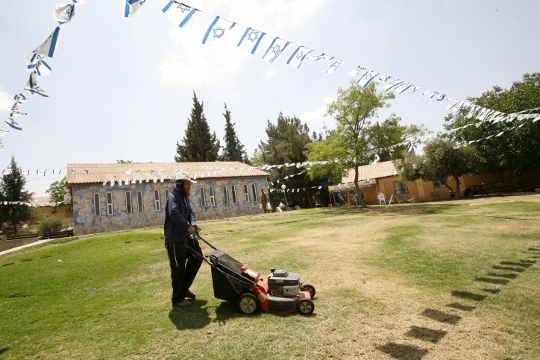Settlers are trying to spin water shortages as a problem that affects both Palestinians and Jews in the same manner. That couldn’t be further from the truth.
By Dror Etkes

The recent reports on water crisis in Palestinian areas of the West Bank were accompanied by a story of another water shortage: this time in Israeli settlements. Let’s get one thing straight — there has never been a “water shortage” in the settlements. When settlers open up the tap at home or in their garden, the amount and quality of the water is identical to that which comes out in most homes to the west of the Green Line. Yes, there were several recent instances in which the water supply was cut off temporarily in a number of settlements (generally for a few hours), during which the authorities provided settlers water from water tanks. One can safely say that not a single settler was left thirsty.
Anyone who has had the opportunity to see how the settlers work the media will not be surprised that the issue made headlines. By exaggerating the water shortage, the settlers hope to achieve two complementary goals: neutralizing criticism of outright discrimination by the the state in everything having to do with the quantity of water sold to Palestinians (which makes up only a small percentage of water in the West Bank, the rest goes to West Bank settlements and Israel), while using the cynical and empty claim that the water shortage affects “both Arabs and Jews.”
The second goal is put pressure on right-wing politicians to approve budgets for establishing new water infrastructure, in order to meet the demand, which will likely skyrocket in the coming years — assuming the number of settlers continues to grow at the current rate (five percent per year, twice as much as the population growth in Israel).
Turning water into wine
The following is the story of water in the West Bank from a less well-known perspective: that of Israeli agriculture. Here are just a few statistics on Israeli agriculture in the West Bank:
Today settlers control almost 25,000 acres in the West Bank. Approximately 19,000 of them are spread out along the Jordan Valley and its northern beach at the Dead Sea. The rest of the land is around settlements and in outposts across the mountainous region in the central and western part of the West Bank. Around 6,800 acres — nearly 30 percent of all Israeli agricultural land in the West Bank — is owned by Palestinians, and which was taken over by settlers in contravention of Israeli military law. This happened with the active aid of the authorities or due to a lack of enforcement.

Following the Oslo Accords, Israeli agricultural land was expanded to a little less than a third of the total agricultural territory owned by settlers. Of all the agricultural land that has been added since, nearly 3,000 acres have popped up around settlements in the hilly areas of the West Bank, where mostly religious, ideological settlers reside. The relative growth of agriculture around these settlements (which were never intended to be agricultural settlements in the first place) was far quicker than that in the Jordan Valley, while the majority of the land transferred over for settler use belongs to their Palestinian neighbors.
Since the signing of the Oslo Accords, Israeli agriculture has become the main driver in taking over new territory in the West Bank, and especially the hilltop settlements. However as opposed to Israeli agriculture in the Jordan Valley — usually on land that Israel took over formally and transferred to settlers — the agriculture around the hilltop settlements is the result of forceful takeovers by the settlers themselves, who enjoy the cooperation and near-total support of the authorities.
The most popular branch of Israel’s hilltop settlements is dedicated to vineyards. Over 1,000 acres of vineyards are planted on private Palestinian land (over half of which was expanded after Oslo). Although this phenomenon is common across the West Bank, the settlements of Shiloh, Kochav HaShachar, Elon Moreh, Psagot, Ofra, and Susya lead the pack.
According to conservative estimates, 170,000 liters of water are necessary for irrigating a fifth of an acre of vineyards per year. If we multiply this number by the number of acres of vineyards planted illegally on private Palestinian land, we reach over 740 million litters of water.

Now divide this number by 250 liters — the average quantity of water consumed per person in Israel — and you can provide enough water for 3 million people for a single day. On the other hand, this same quantity can supply the 4,500 settlers of Kedumim (which experienced a water shortage for several hours some weeks ago) with enough water to last 20 months.
It turns out that Israel’s unwillingness to enforce its own laws, not to mention respect the property rights of Palestinians whose land was stolen, doubly harms those Palestinians. The water that could have been flowing through their hoses is now watering the land that was taken from them and transferred over to their neighbors.
The unequal division of water in the West Bank is connected, among other things, to the fact that Israel allocates large quantities of fresh water for Israeli agriculture adjacent to settlements, a third of which goes to private Palestinian lands, a situation the state should have prevented in the first place.
Dror Etkes follows Israel’s land and settlement policy in the West Bank. This article was first published in Hebrew on Local Call. Read it here.

